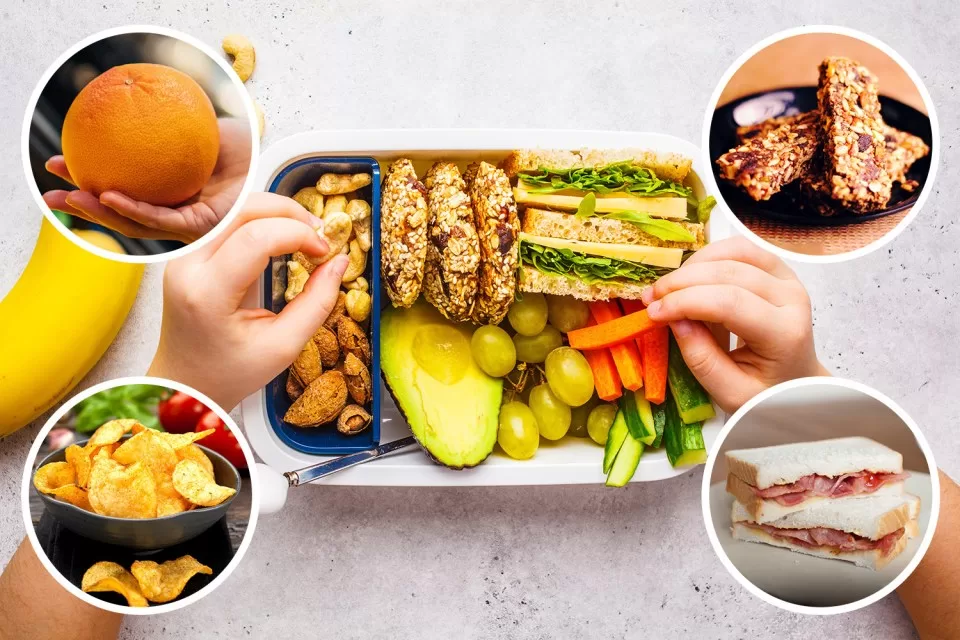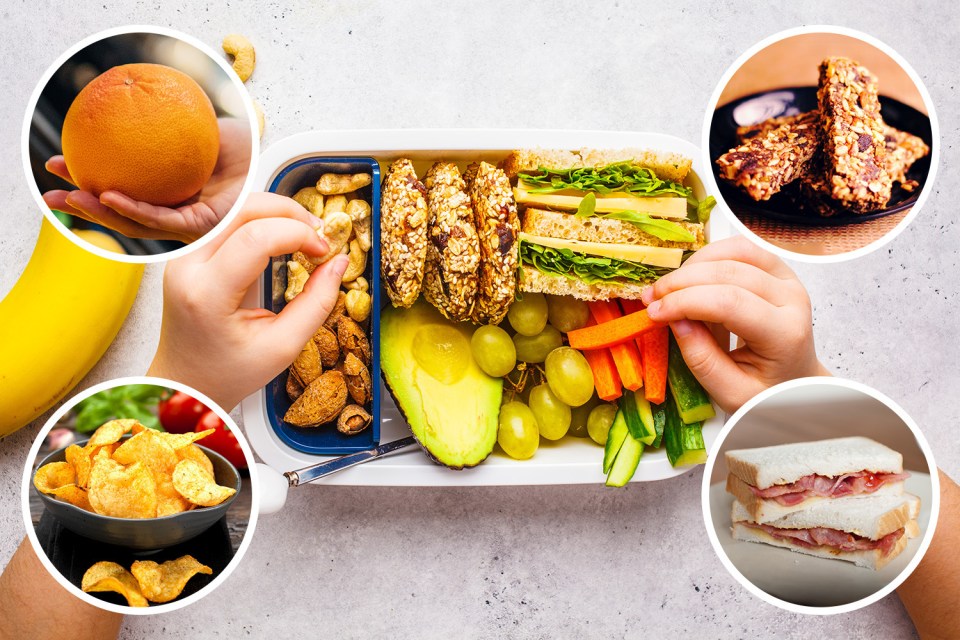WITH school starting back up, no doubt the usual scramble of figuring out what to put in your kid’s lunchbox has commenced.
Finding that sweet spot between foods that are nutritious and tasty enough to satisfy picky tots can be tough.
Speaking of sweet, there are some common lunchbox foods that pack a bigger sugar punch than you’d think.
Triggering sugar highs galore, they’re also not the best choice when it come to protecting your child’s pearly whites.
On top of that, savoury snacks you might you might not think twice about could also be damaging your kid’s oral health, according to dental expert Dr Zaeem Jafri.
“When putting together your children’s lunchbox, it’s important to consider foods that are good for your child’s teeth, and even watch out for the foods that are often marketed as ‘healthy snacks’,” he said.
Read more on back to school
“In 2023, reports stated that nearly 4.5 million children in England had not been seen by an NHS dentist for at least a year.
“This means it’s really important that we look after our kids’ oral health to prevent more serious issues like gum disease developing further down the line.”
Dr Zaeem – who works with Ordo – revealed the five worst lunchbox foods for your child’s teeth, as well as swaps to look after their oral health.
1. Satsumas and easy peelers
Do you regularly pop a satsuma in your tot’s lunchbox to help them reach their five a day?
Dr Zaeem said: “Satsumas and oranges are high in Vitamin C and many of us would think of them as a healthy alternative to a sweet snack.
“However, citrus fruits like satsumas and oranges also happen to be super high in acidity which can cause the enamel to break down when eaten regularly.”
Don’t worry – that doesn’t mean you need to swear off satsumas for good.
“It’s okay to have them occasionally, but definitely don’t make it a regular part of the weekly food shop, as weakened enamel can eventually lead to tooth decay,” the dental expert said.
He suggested you mix it up when it comes to the fruit you pop into your child’s lunchbox.
“Try rotating citrus fruits with crunchy fruits like apples and pears to prevent a build up of damage.
“Fruits are always going to be better than chocolates and sweets but they do come with their own risks.”
He also shared a warning about juice boxes – another school lunch favourite.
“One of the biggest lunchbox issues is fruit juices, because they’re full of sugar and acids,” Dr Zaeem said.
When you eat sugary foods, the bacteria in the mouth ferment them into acid, which can eat away at the tooth enamel.
Dr Zaeem Jafri
“When including oranges in your child’s lunchbox they should be eaten with the whole meal and not as a snack.
“So a good tip is to include some cheese and ask your child to have the cheese afterwards to neutralise the acids!”
2. Salt and vinegar crisps
Do you pop a bag of salt and vinegar crisps in your tot’s lunchbox for a salty treat?
“Despite being one of the most popular crisp flavours in the UK, salt and vinegar flavoured crisps can actually do a fair amount of damage to your child’s mouth,” Dr Zaeem said
“Generally speaking, crisps aren’t a great lunchbox snack because they are high in starch.
“These carbohydrates break down into sugars when eaten and combine with bacteria to produce acids that attack tooth enamel, they also easily get stuck and trapped in the teeth.
“Meanwhile the vinegar in this particular flavour of crisps is very acidic and will doubly attack the enamel.”
3. Cereal bars
Cereal bars can seem like a healthy alternative to biscuits or sweets.
But their packaging can often be deceptive, Dr Zaeem warned.
“Despite the packaging looking like they’re healthy, most cereal bars are super high in sugar, which can also cause tooth decay.
“When you eat sugary foods, the bacteria in the mouth ferment them into acid, which can eat away at the tooth enamel.
“On top of this, cereal bars are sticky and chewy, and often get stuck in children’s teeth.”
How to look after your kid’s oral health
It’s important that children form good oral health habits from a young age to help avoid tooth decay.
Tooth decay happens when sugars from food and drinks interact with bacteria in tooth plaque.
This results in acid production, causing holes in teeth known as cavities.
If children have tooth decay, they may have yellow, brown or black marks on their teeth.
They may also complain about their teeth hurting, particularly when eating or drinking.
Tooth brushing is a major part of keeping your tot’s gnashers healthy.
As soon as a child’s teeth start to come through, they are ready to start.
For effective tooth brushing:
- Use a fluoride toothpaste that contains at least 1000 parts per million (ppm) of fluoride – you can find this information on the packaging. For children over seven, use fluoride toothpaste containing between 1,350ppm and 1,500ppm of fluoride
- Use a smear of toothpaste for children under three, and a pea sized amount for those aged three to six
- Brush in circles for around two minutes, making sure to cover the whole of each tooth
- Brush twice a day, including once just before bed – this allows the fluoride to keep working while children sleep
- Children should spit, not rinse, after brushing – this avoids washing away the fluoride
- Adults should help children to brush their teeth until they are seven years old to make sure they are brushing properly
Cutting down on free sugars is also important.
Free sugars include all sugar added to food and drinks by the manufacturer, cook or consumer.
They are found in foods like:
- Cakes, biscuits and chocolates
- Processed foods – like some jarred sauces, jams and breakfast cereals
- Some flavoured yoghurts
They are also found in natural products like:
- Honey and syrups
- Fruit juices and purees
- Smoothies
Free sugars are not found in:
- Whole fruit and vegetables
- Plain, unflavoured milk and yoghurt
- Water
As well as limiting the amount of free sugars children eat or drink, you should also make sure that they only have food or drinks that contain sugar at mealtimes.
This is because, the more often their teeth come into contact with sugar, the more likely they will be to get tooth decay.
Children should avoid food and drinks containing free sugars before bedtime and overnight.
Source: Department for Education
Though what they eat is a big part of keeping your child’s gnashers healthy, dental hygiene is – unsurprisingly – another major component.
“It’s important to make sure that your child is using a high-quality toothbrush that will get into all those crevices and prevent tooth decay,” Dr Zaeem said.
“Making sure your child is using a toothbrush with soft bristles or an electric toothbrush will make sure the gums are cleaned gently, even with braces or other dental work.”
4. Dried mango
Again, chewy strips of dried mango can seem like a better alternative to your typical sweet snack.
But Dr Zaeem said: “Fruits with minimal water also have the potential to cause tooth damage.
“Dried mango can easily stick to the teeth. This sticky sugar feeds harmful bacteria, which will produce acids that will erode your enamel and irritate your gums.”
The alternative?
“Opting for fresh fruit will always be a better option than dried, so focus on including these in the lunchbox over dried fruits.”
5. White bread
Sandwiches are the ultimate lunchbox staple and oftentimes parents can spend more time thinking about the filling that the bread.
But according to Dr Zaeem, the bread you choose can be pretty important when it comes to your child’s dental health – and unfortunately white bread isn’t the best option.
“White bread is packed full of refined carbohydrates and sugars. If your child doesn’t brush and floss well enough, the sugar and starch can create a breeding ground for bacteria and cavities,” the dental expert explained.
“In addition to this, the grains used to make white bread are processed, which can strip away natural roughage and raise the food’s acid levels.
“You should opt instead for breads made with whole grains.”

